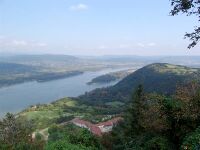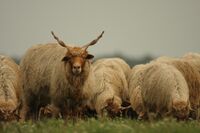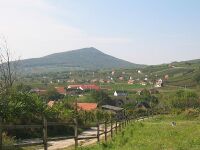Tavonia
| Republic of Tavonia Հանրապետություն Տավարատի Hanrapetut’yun Tavarati (Lusavanic) | |
| Flag | Coat of arms |
|---|---|

|

|
| Motto: Union beneath the Stars (Lusavanic: Միություն տակ Աստղերի; Miutʿyun tak Astłeri) | |
| Anthem: The Struggle of the Stars | |
| Locator map | |

| |
| Capital city | Karmon |
| Largest city | Karmon |
| Official language | Lusavanic |
| Other languages | Anisoran, Parnethian |
| Ethnic group | |
| Religion | Izha, Peratolian Orkanan |
| Demonym(s) | Tavonian, West Lusavanic |
| Government | |
| Government Type | Unitary republic |
| President | Arevik Rubinyan |
| Prime Minister | Alen Arshakyan |
| Legislature | Parliament: Senate (upper house) Chamber of Deputies (lower house) |
| Establishment | |
| Republic proclaimed | 7617 |
| Area | |
| Total | 274,607 km2 |
| Population | |
| Total | 17,072,392 |
| Density | 62.17/km2 |
| Economy | |
| Economy type | Open-market capitalist |
| GDP (total) | Ꞡ 182.1 billion |
| GDP per capita | Ꞡ 10,666.33 |
| Currency | Tag (Թ) |
| Other information | |
| Time zone | 0 |
| Driving side | left |
| Calling code | TAV |
| Internet code | .tv |
Tavonia (Lusavanic: Տավարատ; Tavarat), officially the Republic of Tavonia (Lusavanic: Հանրապետություն Տավարատի; Hanrapetut’yun Tavarati) and sometimes unofficially referred to as West Lusavan, is a unitary republic in central Anaria Minor. Located at the heart of the subcontinent, Tavonia is landlocked and located at the terminus of the Makur Valley, bordered in the west and south by the Bhazen Mountains and Parnethia beyond, to the north-east by Anisora and directly east by East Lusavan. The country covers an area of 274,607 km² (106,026 sq mi) and has a population of over 17 million people. It has a predominately temperate-continental climate, although much of the west and south of the country is heavily mountainous and as such has an alpine climate. The largest lake in Anaria, Lake Karamon, is located mostly within the nation's borders and is renowned for its natural beauty. Tavonia's capital and largest city is Karmon, also known as Karmavush.
The Principality of Tavonia was founded in 7552 after gaining independence from the Anisoran Empire, after the conclusion of the Pan-Anarian War. The land that now makes up modern Tavonia had been ruled by Anisora since the 74th century, acquired by Anisora over the course of numerous wars, including the Anisoro-Lusavanic War (7372-7375). The Kingdom of Lusavan, an Izhaic kingdom which many Tavonians consider to be the modern state's cultural and political predecessor, was dismantled in 7391, when the last remnants of the Kingdom, located in Tavonia, were split between the Anisoran states of Casella and Lusava, which ruled Tavonia until the end of the Pan-Anarian War. After the War ended, in the wake of nationalist calls for an independent Izhaic Lusavanic state, an economically exhausted Anisora was forced to grant Tavonia nominal independence, while installing an Orkanan prince and retaining the status of the new principality's protector according to the Treaty of Asola. As such, while an independent country, Tavonia's foreign policy was de facto controlled by the Anisoran Empire until the final phase of the Anisoran Civil War (7613-7616).
The granting of independence to neighbouring East Lusavan led to widespread calls from Lusavanic nationalists within Tavonia for the unification of the Lusavanic-speaking states, but the Treaty of Marakos precluded the establishment of a unified Lusavan. This led to growing disquiet and nationalist agitation inside Tavonia and led to the outbreak of the Tavonian Revolution in 7617, which overthrew the Anisoran-backed Prince and led to the proclamation of the Tavonian Republic. Pan-Lusavism nevertheless remains an enduring political goal for many in Tavonia, and efforts to unify the country with East Lusavan continues today.
Tavonia is a multi-ethnic, multi-religious and multi-lingual state, with a Lusavanic ethnic majority. The majority of the population are Izhaic, but sizeable minorities of Orkanans live throughout the country, especially in the east and northern mountains. The majority language is Lusavanic, but Anisoran, predominately spoken in the east, and Parnethian, spoken in the south, are both officially recognised languages. The Tavonian language, mutually intelligible with Lusavanic, is also spoken but despite sharing the name of the country, does not have official status. Religious and ethnic tensions have been historically very high in Tavonia, located as it is in the historic fighting ground between the Izhaic west and the Orkanan east, and sectarian violence and tensions with its neighbour Anisora remain enduring issues that drive tensions to this day.
Etymology
The Hallish name Tavonia comes from the Lusavanic name Տավարատ (Tavarat), the modern name for the state. The name is believed to originate from the Old Lusavanic word տուար (tuar), meaning 'cattle', coming into modern Lusavanic as տաւար (tawar), or տավար (tavar). As such the name for the region is believed to be cognate with the 'land of cattle', probably a reference to the Great Tavonian Plain which dominates much of the region, perfect for grazing cattle and other livestock. The name 'Tavonia' is first mentioned by the ancient 53rd century Pastanan geographer Marcus Ferrus, who refers to the people of the area as the tavonii.
History
Prelude to independence
- See also: Lusavan § Lusavanic nationalism
With the Pan-Anarian War drawing to an end, the Lusavanic nationalist movements started formally demanding independence. The Anisoran Empire had informally promised some form of independence in 7547, in return for continued support in the war effort. Although no formal commitments were made, with the details of such an independence kept deliberately vague, the Lusavanic army mutinies and Izhaic riots that had threatened to undermine the Anisoran war effort had been quelled. However, after the War formally ended, many Lusavans suspected the Anisorans would go back on their promises. Many in the Anisoran government were already discussing the creation of a new autonomous state in Tavonia, modelled on the Grand Principality of Lusava and Vascano, which would remain within the Anisoran Empire. Rumours and leaks to this effect brought thousands onto the streets of Karmon, with violence forcing the Anisorans to commit troops to secure the city.
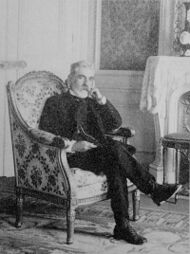
As the Anisoran Chamber of Deputies and Imperial Senate debated the issue of Lusavanic independence, the violence threatened to escalate. Days after the War formally ended, large scale mutinies shook the Imperial Army, with thousands of Lusavanic and Izhaic troops abandoning their posts. In combination with the crippling economic situation the Empire faced after so many decades of fighting and mounting international pressure to establish a stable and long-lasting post-war settlement in Anaria Minor, the Anisoran government came to realise that they could not realistically resist the calls for independence any further.
The Anisoran prime minister Ermino Gagliardi announced on 18th January 7552 that he had entered negotiations with various Lusavanic factions and was drawing up a preliminary commitment to create an independent state in Tavonia, one which would not be a state of the Anisoran Empire. The announcement and the subsequent ratification of the commitment in the Anisoran Chamber of Deputies cooled the growing tension and violence in Karmon, although attacks and strikes still occurred. Vazgen Palyunyan was invited to Pena and emerged as the leading figure in the push for an independent Izhaic state.
Treaty of Asola
An international conference at Asola in Ardennes was formally opened by the King of Ardennes on 2 March 7552. The conference sought to establish the Post-War settlement in Anaria Minor, which included the formal establishment of numerous independent states to create a buffer zone between Anat Tahan and Anisora. With delegations from all the major belligerents of the War, the conference sought to bring a lasting peace to the subcontinent that had seen some of the most intense fighting of the fifty-year conflict. On the first day of formal negotiations, the Anisoran prime minister Gagliardi expressed the impossibility of granting Lusava in its entirety independence, stating that the Anisoran government would only commit to the area known as Tavonia. This caused outrage amongst large sections of the Lusavanic population and rioting erupted in Karmon and Tenevelan. However, by this point the Anisoran Imperial Army had recovered from the mutinies and insurrections of the previous month and was able to establish order in Tenevelan, although in Karmon certain areas of the city remained outside of the Army's control.
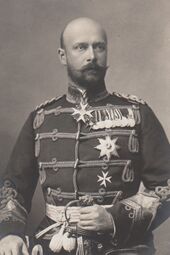
Over the following weeks intense negotiations were held in Asola, Pena, Tenevelan, and Karmon to establish the makeup of the new state. Anisora insisted that the new state be a protectorate of the Anisoran Empire, to ensure the security of the Empire's western border and establish a stable balance of power vis-a-vis Anat Tahan in Anaria Minor. The Anisorans also demanded formal recognition in the Asola Treaty of the Holy Shrines Covenant and the Anisoran Emperor's position as protector of Orkanans in Anaria Minor. While the recognition of the Covenant by an international treaty led many Izhaics to worry that Anisora would use it to legitimise intervention in Anaria Minor, including Anat Tahan, the Covenant was included in the articles of the Treaty of Asola being negotiated.
The borders of the new state were also eventually agreed, with the Grand Principalities of Casella and Lusava ceding land to the new state between them. The new state would be majority Izhaic, but a large proportion of the Lusavanic people would still remain in the Grand Principality of Lusava to the east of the new country. Following a crackdown in the region by Imperial troops, and the international community committed to a speedy conclusion to the conference, Palyunyan and other nationalists realised that there was little hope of creating a Pan-Lusavanic state, and were forced to agree to the borders assigned by the great powers. While many wanted to name the new state Lusavan, the Anisorans vetoed the name, given the fact that the Anisoran Emperor was not prepared to renounce the title of Grand Prince of Lusava. Much to the consternation of the Lusavanic negotiators, the name Tavonia was agreed, taken from the central region of the new state.
Major disagreements remained on the question of who should rule the new state. While the Anisoran government and the majority of the great powers considered the establishment of a royal family in Tavonia to be the obvious course, there were many nationalists that called for a republican government. Despite these calls, however, the installation of a prince as head of state was agreed by the great powers at the Asola Conference. Numerous candidates for Prince were put forward during the course of the conference. The Anisorans wanted a member of an Anisoran royal stim to be installed as Prince, with their preferred candidate being Ludovico of Vattoro, younger brother of Emmanuele V, Prince of Vattoro. However, given the nature of the federal monarchy in Anisora, many Tavonians feared that with an Anisoran dynast on the throne, Tavonia would become in reality another state of the Anisoran Empire, rather than being independent. As such numerous non-Anisoran compromise candidates were approached, although numerous princes refused the offer of the throne. Finally the King of Ardennes, the host of the Asola conference, put forward his younger brother Andrew. Ardennes had been neutral during the Pan-Anarian War, and as such Andrew's candidature was seen as more acceptable to Anat Tahan than an Anisoran prince. Although his Orkanan religion led to many protestations from the Izhaic factions, Prince Andrew's acceptance of the offer of the throne promised Ardennian and international support for Tavonian independence. He was duly 'elected' the first Prince of Tavonia, taking the regal name Aram I.
After the signing of the Treaty of Asola, Tavonian independence was officially granted on 14 April 7552 when Anisoran troops withdrew from the borders of the new state and Prince Andrew assumed his position as Prince of Tavonia. National elections which were to establish the first national government were declared the same day.
Protectorate of the Anisoran Empire
The Principality of Tavonia was a unitary constitutional monarchy, with the Prince of Tavonia as the head of state. The head of government was the prime minister, who was appointed by the Prince, and who was accountable to both the Chamber of Deputies and the Prince. The Tavonian Parliament under the principality was bicameral, with a Chamber of Deputies, modelled on the Anisoran Chamber of Deputies, made up of elected representatives, known as Deputies, who were elected by and represent a local constituency, who served terms of five years. The Senate on the other hand was made up of individuals appointed by the Prince, including members of the royal stim, leading nobles, ex-politicians, civil servants, military personnel and other public figures. Together the two houses debate and passed legislation, with the Prince retaining a veto on any legislation brought before either House. All members of the government needed to be a member of either house, although the ability of the Prince to appoint as many senators as he wished meant that senatorial appointments were common for incoming members of an administration.
Under the Treaty of Asola, the Principality of Tavonia was formally a protectorate of the Anisoran Empire. While it retained its own armed forces, Tavonia was officially reliant upon the Anisoran Empire for matters of defence. There are a number of Anisoran military bases across Tavonia, principally to help defend the mountainous western border and ward against potential Tahani or allied movements. A detachment of the Anisoran Gardini, the elite mountain warfare division of the Anisoran Army, was permanently based at Toranri in the Bhazen Mountains. The Tavonian Constitution, as adopted by the first national government in September 7552, outlined the specific relationship of Tavonia to Anisora. According to the treaty agreement signed at Asola, it is stipulated that:
I. The Principality of Tavonia shall henceforth be governed and administered by the Prince and his successors as an independent State under the protection of the Anisoran Empire; but such protection shall confer no right on His August Imperial Majesty's Government to interfere with the internal administration of the Principality further than is herein provided.
II. In case any question should hereafter arise respecting the rights of succession to the present or any future Prince of Tavonia, such question shall be referred to His August Imperial Majesty's Government for consultation with the Tavonian Government.
III. The relations between the Principality of Tavonia and all foreign States shall be conducted by His August Imperial Majesty's Government, or in accordance with its directions; and if any difference should arise between the Government of Tavonia and that of any other State, the Government of Tavonia agrees to abide by the decision of His August Imperial Majesty's Government, and to take all steps necessary to give effect thereto.
IV. His August Imperial Majesty the Emperor of the Anisorans and His Successors will, according to the Holy Shrines Covenant, be forever recognised as the protector of all Orkanan shrines and Orkanan subjects of the Prince of Tavonia, and the ministers, consular officials, and representatives of His August Imperial Majesty shall be granted rights and privileges in the exercise of this authority within the territories of the Principality of Tavonia.
V. Anisoran subjects and commerce shall enjoy the same right, privileges, and advantages as the subjects, commerce, and shipping of the most favoured nation, as well as any other rights, privileges, and advantages which may be enjoyed by the subjects, commerce and shipping of the Principality of Tavonia.
VI. No cession or other alienation of any part of the territory of the Principality of Tavonia shall be made by the Prince or His successors to any foreign State, or the subjects or the citizens thereof, without the consent of His August Imperial Majesty's Government; but this restriction shall not apply to ordinary grants or leases of lands or houses to private individuals for purposes of residence, agriculture, commerce, or other business.
Tavonian Revolution
The 7612 secessionist movement in the neighbouring Grand Principality of Lusava and the Anisoran Empire's harsh crackdown has been viewed by many Tavonian historians as the key triggerpoint that led to the establishment of the Republic of Tavonia and its decoupling from Anisora. The resultant Anisoran Civil War (7613-7616) severely undermined the stability of Anaria Minor, and Tavonia's status as a protectorate of the Empire. Growing sectarian violence along Tavonia's eastern border with Anisora and the growing threat posed by marauding paramilitary groups, including radical Orkanan unitarian groups, increased already high anti-Anisoran sentiment. Desires for a truly independent Tavonia (either as a separate entity or as part of a unified pan-Lusavanic state) became more pronounced, and republican sentiment led to major protests in Karmon calling for the abolition of the prince and establishment of a Lusavanic, Izhaic republic.
The granting of independence to neighbouring East Lusavan in 7616 led to widespread calls from Lusavanic nationalists within Tavonia for the unification of the Lusavanic-speaking states, but the Treaty of Marakos precluded the establishment of a unified Lusavan. This led to growing disquiet and nationalist agitation inside Tavonia and led to the outbreak of the Tavonian Revolution in 7617, which overthrew Prince Aram II and led to the proclamation of the Tavonian Republic. The state formally withdrew from the Treaty of Asola (7552), which recognised Anisora as the state's protector, and the new 7617 Constitution proclaimed Tavonia as a republic, with an elected head of state.
Geography

Tavonia is located at the terminus of the great Makur Valley in central Anaria Minor, with the Great Tavonian Plains dominating most of the central and east of the country. The source of the Makur River and the largest lake in Anaria, Lake Karamon, is located in the north on the border with Anisora, although the vast majority of the lake falls within Tavonian territory. This region and the surrounding river lands and plains form the south-western part of the Makur river valley which dominates eastern Anaria Minor. The southern and western borders of Tavonia are dominated by the Bhazen Mountains, with the Greater Bhazen Mountains, the tallest mountain range in Anaria Minor, to the west, the North Bhazen Mountains to the north-west, and the Levan Mountains to the south. Much of the south and north-west of the country is dominated by foothills and rolling landscapes that feed the many rivers in the region, the largest of which is the Rasagh River, which like all rivers in Tavonia, flows into Lake Karamon in the north.
The tallest mountain in Anaria Minor, Mount Andorus (6,832 m; 22,414 ft) is partly located in Tavonia, with the eastern col falling within the extreme-western border of Tavonia in the Greater Bhazen Mountains. The tallest mountain that falls entirely within the territory of Tavonia is Mount Pazhdasar (also known as Mount Passada), standing at 6,523 m (21,401 ft). Much of the mountainous regions of Tavonia, including the extensive foothills that dominate the country, are covered in forest, supporting a rich diversity of wildlife.
Tavonia is home to a great variety of flora and fauna. The Tavonian mountains are home to large populations of Anarian brown bears as well as sizeable populations of Anarian Bhazenese wolves, among many other animals of all types, including the Darna sheep, which are farmed across Tavonia and known for their unusual spiral-shaped horns. The region's flora is still more varied, with large quantities of mountain flowers, as well as deciduous trees and various types of native grape varieties grown in the east of the country.
-
Mount Andorus is the tallest mountain in Anaria Minor.
-
The Tarpak River in the Lormen region of southern Tavonia.
-
A flock of Darna sheep in the Great Tavonian Plains in central Tavonia.
-
The Andarat region in eastern Tavonia is known for its viticulture and vineyards.
Government and politics
The modern Republic of Tavonia is a unitary republic, operating under a semi-presidential system. The president is elected directly by universal adult suffrage for a five-year term, and the current president and head of state is Arevik Rubinyan, who is currently serving her second term in office. The head of government is the Prime Minister, who is appointed by the President and is normally the leader of the largest party in the Chamber of Deputies. The current prime minister is Alen Arshakyan, who has led a centre-right National Unity-led government since the 7688 election. The Tavonian Parliament (Խորհրդարան; Khorhrdaran) is bicameral. The lower house is the Chamber of Deputies, made up of elected representatives, known as Deputies, who are elected by and represent a local constituency, who serve terms of five years. The Senate is the upper house, and is made up of elected senators who hold their seats for seven year terms.
Tavonian politics is dominated by two principal political parties, with coalition governments with smaller parties the most common form of administration. The current ruling party, the National Unity Party (Ազգային Միաբանություն; Azgayin Miabanutyun), is a conservative nationalist party known for its Pan-Lusavanic ideology and conservative Izhaic values. National Unity is led by the current Prime Minister of Tavonia, Alen Arshakyan. The main opposition party is the Congress of Tavonia Party (Կոնգրես Տավարատի; Congres Tavarati), and is a socialist-aligned party known for its attempts to appeal to voters across the ethnic, religious and linguistic divides of the country. The current leader of the Congress of Tavonia Party is Vahan Rhasabian.
Foreign relations
Military
The Republic of Tavonia's armed forces are made up of various service branches, with a total strength of 110,000 personnel. The President is Commander-in-Chief of the Tavonian armed forces, which is made up of the Army (Տավարատան բանակ; Tavaratan Banak), the Republican Guard (Հանրապետական Պահակներ; Hanrapetakan Pahakner), the Air Force (Ռազմաօդային Ուժեր; 'Razmaodayin Uzher') and the Gendarmerie (Ժանդարմերիա; Zhandarmeria), a militarised police force under the authority of the military. Being a landlocked country, Tavonia has no official navy, though it retains some training vessels and gendarmerie patrol craft on Lake Karamon.
Economy
The Tavonian economy is operated as an open capitalist market, and is categorised as a middle-income economy with a total GPD of Ꞡ 182.1 billion (Ꞡ 10,666.33 GDP per capita), making it the 74th largest economy on Gotha. The national currency of Tavonia is the Tag (Թ).
The Tavonian economy has historically been heavily reliant upon and interconnected with that of the Anisoran Empire. Having been ruled by Anisora for almost two centuries, and being located at the western terminus of the Makur Valley, with the Bhazen Mountains blocking her western and southern borders, the vast majority of Tavonia's rail and road connections remain orientated eastwards, towards Anisora. Rail and road connections to Tavonia's neighbours to the west and, to a lesser extent the south, remain limited, but recent efforts to ramp up trade with East Lusavan and Parnethia are decreasing Tavonia's reliance upon Anisora.
Between 7552 and 7621, Tavonia was a member of the Anisoran-led West Anarian Customs Union, which further tied the Tavonian economy to Anisora. During this time, tariff-free trade with the existing member states was established, minimising border-checks and encouraging trade between members. As a consequence, over 80% of Tavonian exports had gone to the Anisoran Empire, chiefly the states of Lusava and Vascano and Casella. Equally, Tavonia was heavily reliant upon imports from Anisora, especially food imports, finished industrial products such as machinery. However, since the collapse of the customs union, there have been recent negotiations to re-establish a more equitable customs union in Anaria Minor, but this has so far failed to reach fruition.
Mining is an increasingly important sector of the Tavonian economy, with the Bhazen Mountains in the west home to many productive coal and silver mines, as well as peat production. Tavonia has a modest industrial sector, producing primarily steel as well as farming equipment, predominately in the more industrial regions of central and northern Tavonia. The capital city Karmon is the the centre of Tavonian industry, and remains the most developed urban centre in the country.
Over 40% of the Tavonian population are employed in the agricultural sector, with small land-holders making up a large proportion of the countryside. A number of noble stims and wealthy individuals retain large estates in the north and east which produce grain and wine. Sheep farming and cattle raising are amongst the most widespread economic activities in rural Tavonia, particularly in the hilly and mountainous regions where soil quality is poor. The Darna sheep, recognisable by its unusual spiralled-horns, are the most common form of livestock in Tavonia. A small oilfield in western Tavonia was established in 7560 by the Moreva Petroleum Corporation after deposits of oil were discovered there, but these have now largely dried up, with only residual extraction and processing taking place at the site today.
Demographics
Tavonia is a multi-ethnic, multi-lingual and multi-religious state, with a significant population of numerous minority groups dotted throughout the country. According to the 7689 census, the total population of Tavonia stood at 17,072,392, with a population density of approximately 62.17 people per square kilometre (161 per square mile), one of the lowest in Anaria.a
Ethnically, Tavonia is highly diverse. While the vast majority of the population are categorised as belonging to the Athves umbrella ethnic grouping, this arbitrary classification is essentially meaningless as the country is divided into several unique and fiercely independent ethnic groupings. The majority of the population identify as Lusavan, while only a very small minority identify as 'Tavonian'. The concept of a 'Tavonian people' is highly controversial, with many Lusavanic nationalists such as Moran Doramyan rejecting the label as an 'Anisoran imperialist construct designed to divide the Lusavanic nation and people'.b Doramyan, like many others in Tavonia, consider 'Tavonian' to be a geographic descriptor only, with no independent ethnic, cultural or linguistic meaning. This hardline Lusavanic nationalist stance is not universally accepted, however. The Congress of Tavonia Party, which has remained a dominant political force in Tavonia since independence, considers one of its missions to protect a 'Tavonian' nationalism, where Tavonian citizens, regardless of ethnicity, language or religion, can find common cause. While the period of optimism post-independence in the 7550s is largely accepted to be over, over the last one hundred years a growing number of supporters of the Congress believe a common Tavonian identity is something that should be protected.
Other ethnic minorities include Anisorans, further subdivided into Casellans, Vascanese, Parronese, and Maronan. Anisoran populations are mostly located in the north east, along the border with the Anisoran Empire. A reasonable number of Parnethians live on the southern border in the Levan Mountains. Numerous other minority communities live across Tavonia, including a significant number of ethnic groups living in isolated villages in the Greater Bhazen Mountains in the west.
Religions

Tavonia has had a very rich, and very bloody, religious history. Situated in central Anaria Minor between the Izhaic west and the Orkanan east, over the last millennium Tavonia has been a principle battleground between these two religions. With the proselytising Izhaic sects of Tharna spreading Izha to Anaria Minor in the early 7th millennium, largely removing Sadarisnism from the region, the Peratolian Orkanan congregations to the east radicalised in response. As a consequence a series of religiously motivated conflicts, wars, and atrocities soaked the Tavonian lands in blood, with mass conversions, religious oppression, and religio-ethnic displacements common throughout the region's history. Religous sectarian violence remains an enduring feature of parts of Tavonia to this day, principally between radical Izhaic and Orkanan minorities. The various holy shrines dotted across Tavonia have in particular remained key sources of tensions, with Orkanan radical unitarian paramilitary groups attempting to enforce aspects of the Holy Shrines Covenant, and radical Izhaic paramilitary groups opposing them.
The majority religion of Tavonia is Norynan Izhaic, with over 60% adhering to the sect. Peratolian Orkanan remains the largest non-Izhaic minority religion, which is practicsed predominately in the eastern provinces and represents around 12% of the population.
Languages
The official language of Tavonia is Lusavanic, one of the most widely spoken Heyelrem languages, and is mutually intelligible with the Tavonian language. Despite bearing the name of the country, Tavonian is a minority language spoken primarily in the west of Tavonia and does not have official status, with an approximate population of around 440,000 native speakers. Both languages use the Ralvaran script of a 39 letter alphabet, which is used by most Heyelrem languages. Although this is the most common form of script, Dragaric script is also sometimes used, particularly in the east of the country. Most official documentation is normally presented in both Ralvaran and Dragaric scripts, for ease of comprehension.
Being a multi-lingual state, Tavonia has numerous other minority languages, both officially recognised and not. Besides Tavonian, the most widely spoken minority languages are Anisoran, spoken along the eastern border with Anisora, and Parnethian, which is spoken predominately in the south, especially in the valleys of the Levan Mountains. According to the original 7552 Tavonian Constitution, and subsequently upheld in the 7617 Constitution, the speakers of these two principle minority languages, Anisoran and Parnethian, are protected, with various rights upheld. Numerous other languages are spoken throughout Tavonia however, with a number of isolated language groups and Heyelrem or Delphinic regional languages and dialects located in the mountainous regions. The Bhazen Mountains are home to many isolated mountain communities, many of whom retain their own unique language or dialects, although non of these languages are officially recognised.
Culture
- Main article: Lusavanic culture
See also
Notes
References
a Tavonian Ministry of the Interior (7572) Երկրորդ Ազգային Մարդահամարը (7572) (Yerkrord Azgayin Mardahamary (7572)). Karmon. 12. (Hallish: Second National Census (7572))
b Doramyan, M. (7554) Լուսևաներեն Ազգը (Lusavaneren Azgy). Tranderan. 35-36. (Hallish: The Lusavanic Nation)

